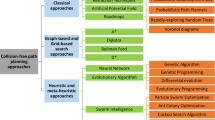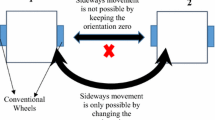Abstract
In this paper, the robot dynamics are represented by a nonlinear state-space model containing a disturbance term due to gravitational loading. Using a suitable linear time-invariant reference model, an adaptive model-following control problem is formulated which satisfies the matching conditions. The control input is designed to have two components: a nonadaptive linear component to do the task of model-following and a nonlinear unit-vector component based on hyperstability theory to do the adaptive task. An additional integral feedback term is further superimposed and then the overall asymptotic hyperstability is established. The simulation results on the first three joints of PUMA 560 robot manipulator indicate the potential of our design approach.
Similar content being viewed by others
References
Landau, I.D.,Adaptive Control: the Model Reference Approach, Marcel Dekker, New York, 1979.
Narendra, K.S. and Lin, Y.-H., Design of stable model reference adaptive controllers, in K.S. Narendra and R.V. Monopoli (eds),Applications of Adaptive Control, Academic Press, New York, 1980.
Dubowsky, S. and DesForges, D.T., The application of model referenced adaptive control to robotic manipulators,J. Dynamic Syst., Meas., Contr. 9ASMEO 101 (1979), 193–200.
Lee, C.S.G. and Chung, M.J., An adaptive control strategy for mechanical manipulators,IEEE Trans. Automat. Contr. AC-29 (1984), 837–840.
Kim, B.K. and Shin, K.G., An adaptive model following control of industrial manipulators,IEEE Trans. Aerospace Electronic Syst. AES-19 (1983), 805–814.
Stoten, D.P., A unified approach to the decoupled discrete adaptive control of manipulators,IEEE Proc. D 132 (1985), 151–157.
Hsia, T.C., Adaptive control of robot manipulators. A review,Proc. IEEE Int. Conf. Robotics and Automation, San Francisco, CA, 1986.
Lim, K.Y. and Eslami, M., Robust adaptive controller designs for robot manipulator systems,IEEE J. Robotics and Automation RA-3 (1987), 54–66.
Koivo, A. and Guo, T., Adaptive linear controller for robotic manipulators,IEEE Trans. Automat. Contr. AC-28 (1983), 162–171.
Slotine, J.J.E. and Li, W., On the adaptive control of robot manipulators,Int. J. Robotics Res. 6 (1987), 49–59.
Ortega, R. and Spong, M.W., Adaptive motion control of rigid robots: A tutorial,Automatica 25 (1989), 877–889.
Spong, M.W. and Ortega, R., On adaptive inverse dynamics control of rigid robots,IEEE Trans. Automat. Contr. AC-35 (1990).
Balestrino, A., De Maria, G. and Zinober, A., Nonlinear adaptive model following control,Automatica 20 (1984), 559–568.
Stoten D.P.,Model Reference Adaptive Control of Manipulators, Research Studies Press, England, 1990.
Belman, R.E.,Matrix Analysis, McGraw-Hill, New York, 1968.
Tarn, T.J., Bejczy, A.K. and Yun, X., Washington University Robotic Lab Report No. SSM-RL-85-02, July 1985.
Author information
Authors and Affiliations
Additional information
Based on research supported by Kuwait University Research Administration under Grant No. EE 049.
Rights and permissions
About this article
Cite this article
Mahmoud, M.S., Bahnasawi, A.A. A design approach to adaptive model-following control of robotic manipulators. J Intell Robot Syst 10, 191–207 (1994). https://doi.org/10.1007/BF01258228
Received:
Accepted:
Issue Date:
DOI: https://doi.org/10.1007/BF01258228




